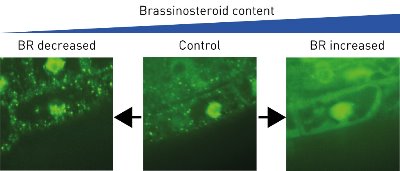May 1, 2015 Research Highlight Biology
Plants' control complex
A newly discovered protein complex controlling a key signaling pathway in plants could be harnessed to enhance biomass production
 Figure 1: Complexes of BSS1 (bright spots) are more pronounced under low brassinosteroid (BR) concentration (left) than under normal (center) and elevated brassinosteroid (right) conditions. © 2015 Takeshi Nakano, RIKEN Antibiotics Laboratory and RIKEN Center for Sustainable Resource Science
Figure 1: Complexes of BSS1 (bright spots) are more pronounced under low brassinosteroid (BR) concentration (left) than under normal (center) and elevated brassinosteroid (right) conditions. © 2015 Takeshi Nakano, RIKEN Antibiotics Laboratory and RIKEN Center for Sustainable Resource Science
The discovery of a previously unknown regulatory system in plants by RIKEN researchers opens up a new avenue for the engineering of more productive crops1.
The multidisciplinary study, bringing together researchers from several RIKEN laboratories and other institutions in Japan, started with the chemical and genetic screening of the model plant Arabidopsis. The screens identified a protein called BIL1 that regulates the action of a staggering 3,000 genes—10% of the Arabidopsis genome. The research team then focused on determining how this ‘master switch’ was itself controlled.
“BIL1 has an interesting dynamic in that it appears to move to the cell nucleus from the surrounding cell fluid, or cytosol, under treatment with the plant hormone brassinosteroid,” says team leader Takeshi Nakano from the RIKEN Antibiotics Laboratory and RIKEN Center for Sustainable Resource Science.
Brassinosteroids and their associated signaling pathways are known to have far-reaching effects on growth and development as well as environmental responses, but the mechanism by which these hormones specifically induced movement of BIL1 to the cell nucleus was unclear. Nakano’s team, however, discovered the presence of a second protein, BSS1, which appears to suppress brassinosteroid signaling and enhance growth and development in leaves and young stems.
The researchers found that BSS1 occurred as small spots, called ‘puncta’, throughout the cytosol, which were most numerous in the absence of brassinosteroids and dissolved under brassinosteroid-rich conditions (Fig. 1). Using high-speed centrifugation to separate the components of the cytosol, they determined that the puncta were actually complexes of multiple BSS1 molecules.
Further analyses showed that the BSS1 complexes ‘capture’ BIL1, preventing its transport to the nucleus. In low-brassinosteroid conditions, BSS1 complexes bind BIL1, suppressing brassinosteroid signaling. When brassinosteroids are present, the complexes break down into single BSS1 molecules, releasing BIL1. This protein then passes into the nucleus, where it switches thousands of genes on or off, resulting in increased plant growth.
Many fascinating questions about this system remain to be resolved. “We don’t know, for example, how the BSS1 protein complex captures BIL1, or how BIL1 is released,” says Nakano. “We guess that formation of the complex changes the protein’s structure or electronegativity, making it attractive to BIL1, but this has yet to be proven. Our future work aims to reveal this mechanism.”
Nakano predicts that genetically modified plants with reduced BSS1 activity could fix more carbon to the plant body. Harnessing the interaction between BSS1 and brassinosteroids could therefore lead to enhanced biomass generation and more productive crops.
References
- 1. Shimada, S., Komatsu, T., Yamagami, A., Nakazawa, M., Matsui, M., Kawaide, H., Natsume, M., Osada, H., Asami, T. & Nakano, T. Formation and dissociation of the BSS1 protein complex regulates plant development via brassinosteroid signaling. The Plant Cell 27, 375–390 (2015). doi: 10.1105/tpc.114.131508
